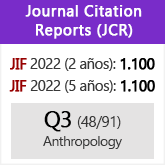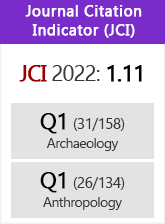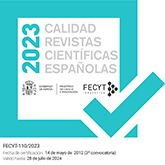Metal para Zambujal: reconstrucción experimental de una tecnología de 5.000 años
DOI:
https://doi.org/10.3989/tp.2010.10040Palabras clave:
Zambujal, Metallurgia de cobre, Calcolítico, Arqueología experimental, Fundición en vasijaResumen
Una serie de 17 experimentos de fundición fueron llevados a cabo como parte de un proyecto de investigación interdisciplinar, que fue iniciado con el propósito de entender las innovaciones en el ámbito de la metalurgia del cobre que se dieron en el centro y el sur de Portugal durante la Edad de Cobre. La tecnología de fundición utilizada en los experimentos fue recreada conforme a información recopilada y a artefactos encontrados en sitios arqueológicos, principalmente en Zambujal y otros lugares pertenecientes a la Estremadura Portuguesa. Asimismo, los minerales de cobre usados durante la fase experimental fueron recolectados en cinco yacimientos minerales de Portugal. El mineral y los productos finales del proceso de fundición fueron analizados mineralógica y geoquímicamente, para después ser comparados con el resto de las muestras arqueológicas. En el presente documento se discuten los resultados del estudio comparativo. Por último, se presenta una discusión del papel que tiene la producción de cobre en la sociedad del centro y del sur de Portugal durante el Calcolítico, basado en observaciones realizadas durante los experimentos.
Descargas
Citas
Alcalde, G.; Molist, M.; Montero, I.; Planagumà, L.; Saña, M. and Toledo, A. 1998: “Producciones Metalúrgicas en el Nordeste de la Península Ibérica durante el III milenio a.C.: el Taller de la Bauma del Serrat del Pont (Tortellà, Girona)”. Trabajos de Prehistoria 55: 81-100. doi:10.3989/tp.1998.v55.i1.318
Anfinset, N. 2000: “Mining and Smelting Copper in Contemporary Nepal. A Discussion of its Form, Function and Context”. In H. Vankilde and D. Olausson (eds.): Form, Function and Context. Acta Archaeologica Lundensia 31: 203-212.
Arribas Palau, A.; Craddock, P.; Molina, P.; Rothenberg, B. and Hook, D. 1989: “Investigación arqueo-metalúrgica en yacimientos de las Edades del Cobre y del Bronce en el Sudeste de Iberia”. En C. Domergue (ed.): Coloquio internacional sobre minería y metalurgia en las antigias civilizaciones mediterráneas y europeas (Madrid 1985): 71-79. Madrid.
Bourgarit, D. and Mille, B. 1997: “La métallurgie chalcolithique de Cabrières: confrontation des données expérimentales et archéologiques en laboratoire”. Archéologie en Languedoc 21: 51-63.
Bourgarit, D.; Mille, B.; Prange, M.; Ambert, P. and Hauptmann, A. 2003: “Chalcolithic Fahlore Smelting at Cabrières: Reconstruction of Smelting Processes by Archaeometallurgical Finds”. Archaeometallurgy in Europe (Milano 2003) 1: 431-440. Milano.
Bourgarit, D. and Mille, B. 2005: “Nouvelles données sur l’atelier métallurgique de la Capitelle du Broum (District Minier de Cabrières, Hérault, France): la transformation de minerais de cuivre à base de sulfures se precise”. In: P. Ambert and J. Vaquer (eds.): La première métallurgie en France et dans les Pays Limitrophes. Actes du Colloque International (Carcassonne 2002). Mémoire de la Société Préhistorique Française XXXVII: 97-108.
Chapman, R. 1990: Emerging complexity: The later prehistory of south-east Spain, Iberia and the west Mediterranean. Cambridge University Press. Cambridge.
Childe, V.G. 1957: The Dawn of Civilisation. Routledge & Kegan Paul Ltd. London.
Childes S. and Killick, D. 1993: “Indigenous African Metallurgy: Nature and Culture”. Annual Review of Anthropology 22: 317-337. doi:10.1146/annurev.an.22.100193.001533
Delibes de Castro, G.; Fernández-Miranda, M.; Fernández-Posse, M.; Martín, C.; Montero, I. and Rovira, S. 1991: “Almizaraque (Almería, Spain): Archaeometallurgy during the Chalcolithic in the southeast of the Iberian Penisnula”. In: J.P. Mohen (ed.): Découverte du metal: 303-315. Picard. Paris.
Etiégni, L. and Campbell, A.G. 1991: “Physical Characteristics of Wood Ash”. Bioresource Technology 37: 173-178. doi:10.1016/0960-8524(91)90207-Z
Fasnacht, W. 1999: “Experimentelle Rekonstruktion des Gebrauchs von frühbronzezeitlichen Blasdüsen aus der Schweiz: Kupferverhu.ttung und Bronzeguß”. Experimentelle Archäologie 8: 237-246.
Gauß, R. in press: Zambujal und die Anfänge der Metallurgie in der Estremadura (Portugal): Technologie der Kupfergewinnung, Herkunft des Metalls und soziokulturelle Bedeutung der Innovation. Iberia Archaeologica 15,2.
Goldenberg, G.; Hanning, E. in press: “Montanarchäologische Prospektion in Portugal (Alentejo und Algarve, 2004-2007)”. Iberia Archaeologica 15,1.
Gómez Ramos, P. 1999: Obtención de Metales en la Prehistoria de la Península Ibérica. BAR International Series 753. Archaeopress. Oxford.
Gonçalves, V.S. 1987: “O povoado pré-histórico da Sala N.º 1 (Pedrógão, Vidigueira): notas sobre a campanha” Portugalia. Nova Série 8: 7-16.
Hanning 2008: Early Copper Metallurgy on the Iberian Peninsula - an archaeometallurgical approach. Unpublished M.A. Thesis. Albert-Ludwigs-Universität, Freiburg i. Br.
Happ, J. 1998: “La découverte de la métallurgie du cuivre à travers l’expérimentation”. In M. Frère-Sautot (ed.): Paléométallurgie des cuivres. Actes du colloque (Bourg-en-Bresse et Beaune 1997). Monographies Instrumentum 5: 17-27. Montagnac.
Hauptmann, A. 2007a: The archaeometallurgy of copper: The evidence from Faynan, Jordan. Springer Verlag. Berlin. doi:10.1007/978-3-540-72238-0
Hauptmann, A. 2007b: “Alten Berg- und Hüttenleuten auf die Finger geschaut: Zur Entschlu.sselung berg-und hu¨ttenma¨nnischer Techniken”. In G. Wagner, Einführung in die Archäometrie. Springer. Berlin. 117-139.
Höppner, B.; Bartelheim, M.; Huijsmans, M.; Krauss, R.; Martinek, K.P.; Pernicka, E. and Schwab, R. 2005: “Prehistoric copper production in the Inn Valley (Austria), and the earliest copper in Central Europe”. Archaeometry 47.2: 293-315.
Hook, D.; Freestone, I.; Meeks, N.D.; Craddock, P.T. and Moreno Onorato, A. 1991: “Early production of copper-alloys in south-east Spain”. In E. Pernicka and G.A. Wagner (eds.): Archaeometry ’90. Proceedings of the International Archaeometry Symposium (Heidelberg 2-6 April 1990). Birkhauser Verlag, Basel: 65-76.
Hunt Ortiz, M.; Hurtado Pérez, V.; Montero Ruiz, I.; Rovira Liorens, S. and Santos Zalduegui, J. 2009: “Chalcolithic metal production and provenance in the site of San Blas. Cheles, Badajoz, Spain”. In Archaeometallurgy in Europe 2007. 2nd International Conference. Grado Aquileia. Selected Papers: 81-92.
Hurtado Pérez, V. 2004: “San Blas: The discovery of a large chalcolithic settlement by the Guadiana river”. Journal of Iberian Archaeology 6: 93-116.
Kunst, M. and Lutz, N. 2008: “Zambujal (Torres Vedras, Portugal). Zur Präzision der absoluten Chronologie durch die Untersuchungen an der vierten Befestigungslinie”. Madrider Mitteilungen 49: 29-63.
Lechtmann, H. 1996: “Arsenic bronze: dirty copper or chosen alloy? A view from the Americas”. Journal of Field Archaeology 23: 477-514. doi:10.2307/530550
Leisner, V. and Schubart, H. 1966: “Die kupferzeitliche befestigung von Pedra do Ouro, Portugal”. Madrider Mitteilungen 7: 9-60. Lorscheider, F. 1998: Experimentalarchäologische Untersuchung zur Verhu.ttung von Fahlerzen und ihre Konsequenzen für die frühe Kupfermetallurgie. Unpublished M.A. Thesis. Albert-Ludwigs- Universität, Freiburg i. Br.
Merkel, J.F. 1990: “Experimental reconstruction of bronze age copper smelting based on archaeological evidence from Timna”. In B. Rothenberg (ed.): The ancient metallurgy of copper: archaeology-experiment-theory. Institute for Archaeo-Metallurgical Studies. London: 78-120.
Mille, B. and Bourgarit, D. 1998: “Du minerai de cuivre sulfré exploité dès le Chalcolithique: les exemples de Cabrières (Hérault) et Al Claus (Tarn et Garonne)”. In M.C. Frère-Sautot (ed.): Paléométallurgie des cuivres. Monographies Instrumentum 5: 27-36.
Miller, D. 1994: “Kaonde Copper Smelting: Technical Versatility and the Ethnographic Record”. In S.T. Childs (ed.): Society, Culture and Technology in Africa. Masca Research Papers in Science and Archaeology 11 (supplement): 79-85.
Montero, I. 1993: “Bronze Age metallurgy in southeast Spain”. Antiquity 67: 46-57.
Müller, R. 2008: Zambujal und die Anfänge der Metallurgie in der Estremadura (Portugal): Technologie der Kupfergewinnung, Herkunft des Metalls und soziokulturelle Bedeutung der Innovation. Unpublished PhD-Thesis. Eberhard-Karls-Universität Tübingen.
Müller, R.; Rehren, Th. and Rovira, S., 2004: “Almizaraque and the early copper metallurgy of southeast Spain: new data”. Madrider Mitteilungen 45: 33-56.
Müller, R.; Rehren, Th. and Rovira, S. 2006: “The question of early copper production at Almizaraque, SE Spain”. 34th International Syposium on Archaeometry (Zaragoza 2004): 209-219. Zaragoza.
Müller, R.; Goldenberg, G.; Bartelheim, M.; Kunst, M. and Pernicka, E. 2007: “Zambujal and the beginnings of metallurgy in southern Portugal”. In S. La Niece, D. Hook and P. Craddock (eds.): Metals and Mines: Studies in Archaeometallurgy. Archetype Publications. Oxford: 15-26.
Müller, R. and Cardoso, J.L. 2008: “The Origin and use of copper at the Chalcolithic fortification of Leceia (Oeiras, Portugal)”. Madrider Mitteilungen 49: 64-93.
Müller, R. and Soares, A.M.M. 2008: “Traces of early copper production at the Chalcolithic fortification of Vila Nova de São Pedro”. Madrider Mitteilungen 49: 94-114.
Müller, R. and Pernicka, E. 2009: “Chemical analysis in archaeometallurgy: a view on the Iberian Peninsula”. In T. Kienlin and B. Roberts (eds.): Metals and Societies. Studies in honour of Barbara Ottaway. Universitätsforschungen zur prähistorischen Archäologie Band 169: 296-306. Bonn.
Nocete Calvo, F. (coord.) 2004: Odiel: proyecto de investigación arqueológica para el análisis del origen de la desigualdad social en el suroeste de la península ibérica. Junta de Andalucía. Consejería de Cultura, Sevilla.
Nocete, F.; Queipo G.; Sáez, R.; Nieto, J.M.; Inácio, N.; Bayona, M.R.; Peramo, A.; Vargas, J.M.; Cruz- Auñón, R.; Gil-Ibarguchi, J.I. and Santos, J.F. 2008: “The smelting quarter of Valencina de la Concepción (Seville, Spain): the specialized copper industry in a political centre of the Guadalquivir Valley during the Third millennium BC (2750-2500 BC)”. Journal of Archaeological Science 35: 717-732. doi:10.1016/j.jas.2007.05.019
O’Brien, W. 2004: Ross Island: Mining metal and society in early Ireland. Bronze Age Studies 6. Dept. of Archaeology N.U.I Galway.
Ottaway, B. 1994: Prähistorische Archäometallurgie. Verlag Marie Leidorf. Espelkamp.
Rehder, J. 1994: “Blowpipes versus bellow in ancient metallurgy”. Journal of Field Archaeology 21.3: 345-350. doi:10.2307/530335
Rostoker, W.; Pigott, V. and Dvorak, J. 1989: “Direct reduction to copper metal by oxide-sulfide mineral interaction”. Archeomaterials 3: 69-87.
Rovira, S. 1998: “Metalurgia campaniforme en España: Resultados de quince años de investigación arqueometalúrgica”. In M. Frère-Sautot (ed.): Paléométallurgie des cuivres. Actes du colloque (Bourg-en-Bresse et Beaune 1997) Monographies Instrumentum 5: 109-117. Montagnac.
Rovira, S. 2002: “Early slags and smelting by-products of copper metallurgy in Spain”. In M. Bartelheim, E. Pernicka and R. Krause (eds.): Die Anfänge der Metallurgie in der alten Welt. Archäometrie - Freiberger Forschungen zur Altertumswissenschaft 1. Leidorf Verlag, Rahden/Westfalen: 83-98.
Rovira, S. 2004: “Technologiá Metalurgica y Cambio Cultural en la Prehistoria de la Península Ibérica”. Norba Revista de Historia 17: 9-40.
Rovira, S. 2005: “Tecnología Metalúrgica Campaniforme en la Península Ibérica. Coladas, moldeado y tratamientos postfundición”. In Rojo, M.A. Guerra, R. Garrido-Pena and I. García-Martínez de Lagrán (eds.): El Campaniforme en la Península Ibérica y su Contexto Europeo. Junta de Castilla y León. Valladolid. 495-521.
Rovira, S. 2006: “Metalurgia de crisol: la obtención de cobre en la prehistoria de la Península Ibérica”. De Re Metallica: 37-44.
Rovira, S. and Ambert, P. 2002: “Les céramiques à réduire le minerai de cuivre: une technique métallurgique utilisée em Ibérie, son extension en France méridionale”. Bulletin de la Société Préhistorique Française 99.1: 105-126.
Rovira, S. and Gutiérrez, A. 2003: “Crónica de un proceso de fundición experimental de minerales de cobre.” In J. Fernández Manzano and J. Herrán Martínez (eds.): Mineros y Fundidoers en el inicio de la edad de los Metales: El Midi francés y el Norte de la Península Ibérica. Caja España. León: 70-74.
Rovira, S. and Guttierez, A. 2005: “Utilisation expérimentale d’un four primitive pour fonder du minerai de cuivre”. In P. Ambert and J. Vaquer (eds.): La Première Métallurgie en France et dans les Pays Limitrophes. Actes du colloque international (Carcassone 2002). Société Préhistorique Française Mémoire XXXVII: 241-248.
Ryndina, N.; Indenbaum, G. and Kolosova, V. 1999: “Copper Production from Polymetallic Sulphide Ores in the Northeastern Balkan Eneolithic Culture”. Journal of Archaeological Science 26: 1059-1068. doi:10.1006/jasc.1999.0410
Sáez Ramos, R.; Nocete Calvo, F.; Capitán, A.; Dolores, M. and Rovira, S. 2003: “The extractive metallurgy of copper from Cabezo Juré, Huelva, Spain: Chemical and mineralogical study of slags dated to the third millennium b.c.”. The Canadian Mineralogist 41.3: 627-638.
Sahlins, M. 1972: Stone Age economics. Aldine de Gruyter. New York.
Sangmeister, E. 1995: “Zambujal. Kupferfunde aus den Grabungen 1964 bis 1973”. In E. Sangmeister and M.d.L.C Jiménez Gómez (eds.): Zambujal. Kupferfunde aus den Grabungen 1964 bis 1973: Los Amuletos de las Campaños 1964 hasta 1973. Madrider Beiträge 5.3. Mainz.
Sangmeister, E. and Schubart, H. 1981: Zambujal. Die Grabungen 1964 bis 1973. Madrider Beiträge 5.1. Philipp von Zabern, Mainz.
Shalev, S.; Happ, J. and Frere-Sautot, M. 2003: “How could have the chalcolithic people from southern Israel produced their copper tool, more than six thousand years ago?” Cu+ 3: 5.
Shimada, I.; Epstein, S. and Craig, A. 1982: “Batan grande: A prehistoric metallurgical center in Peru”. Science 216: 954-959. doi:10.1126/science.216.4549.952 PMid:17809051
Siret, H. and Siret, L. 1888: Les Premiers Ages du Métal dans la Sud-Est de l’Espagne. Extrait de la Bévue des questiotis scientifiques. Bruxelles.
Tylecote, R. 1975: “Can copper be smelted in a crucible?”. Historical Metallurgy Group Bulletin 8: 54.
Tylecote, R. 1980: “Furnaces, crucibles, and slags”. In T. Wertime and J. Muhly (eds.), The coming of the age of iron. Yale University Press. London: 183-228.
Tylecote, R. 1987: The early history of metallurgy in Europe. Longman. London.
Zwicker, U.; Greiner, H.; Hofmann K.H. and Reithinger, M. 1985: “Smelting, refining, and alloying of copper and copper alloys in crucible-furnaces during prehistoric up to Roman time”, in P.T. Craddock and M.J. Hughes (eds.): Furnaces and Smelting Technology in Antiquity. British Museum Occasional Paper 48: 103-116. London.
Descargas
Publicado
Cómo citar
Número
Sección
Licencia
Derechos de autor 2010 Consejo Superior de Investigaciones Científicas (CSIC)

Esta obra está bajo una licencia internacional Creative Commons Atribución 4.0.
© CSIC. Los originales publicados en las ediciones impresa y electrónica de esta Revista son propiedad del Consejo Superior de Investigaciones Científicas, siendo necesario citar la procedencia en cualquier reproducción parcial o total.Salvo indicación contraria, todos los contenidos de la edición electrónica se distribuyen bajo una licencia de uso y distribución “Creative Commons Reconocimiento 4.0 Internacional ” (CC BY 4.0). Puede consultar desde aquí la versión informativa y el texto legal de la licencia. Esta circunstancia ha de hacerse constar expresamente de esta forma cuando sea necesario.
No se autoriza el depósito en repositorios, páginas web personales o similares de cualquier otra versión distinta a la publicada por el editor.

















